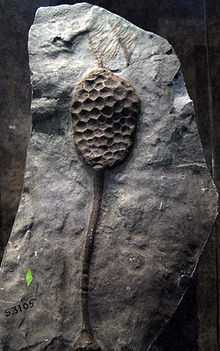Paracrinoidea
| Paracrinoid Temporal range: Early Ordovician - Early Silurian | |
|---|---|
 | |
| Comarocystites punctatus | |
| Scientific classification | |
| Kingdom: | Animalia |
| Phylum: | Echinodermata |
| Subphylum: | Crinozoa |
| Class: | Paracrinoidea |
Paracrinoidea is an extinct class of Crinozoan echinoderms closely related to, and superficially resembling sea lilies. They lived in shallow seas during the Early Ordovician through the Early Silurian.
Paracrinoids are characterized by a mouth with two to five feeding arms arranged asymmetrically, or somewhat bisymmetrically. They have a U-shaped gut, and their anus is located next to the mouth. They have irregularly shaped bodies (theca), and a stem, similar to crinoids, and may have used the stem to attach themselves to a substrate, although some reconstructions show them partially buried in sediment.[1]
Only 13 to 15 genera are known.
References
- ↑ Fossil Invertebrates, 1987, Boardman, Richard S., Cheetham, Alan H., and Rowell, Albert J., editors, pp. 580-1. Blackwell Scientific Publications.